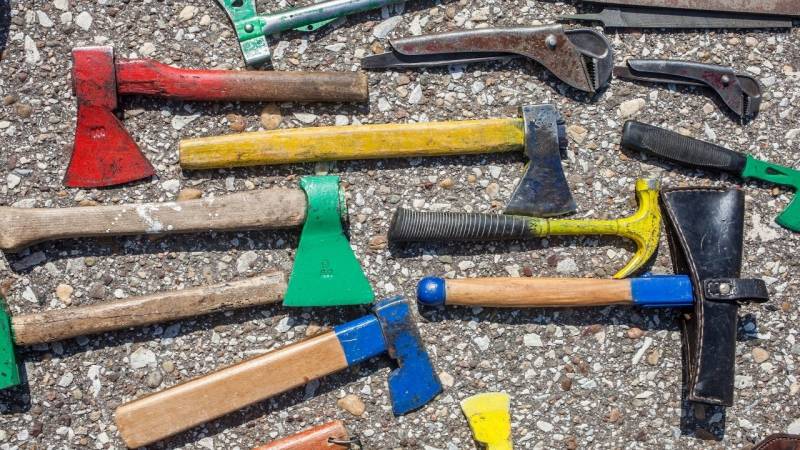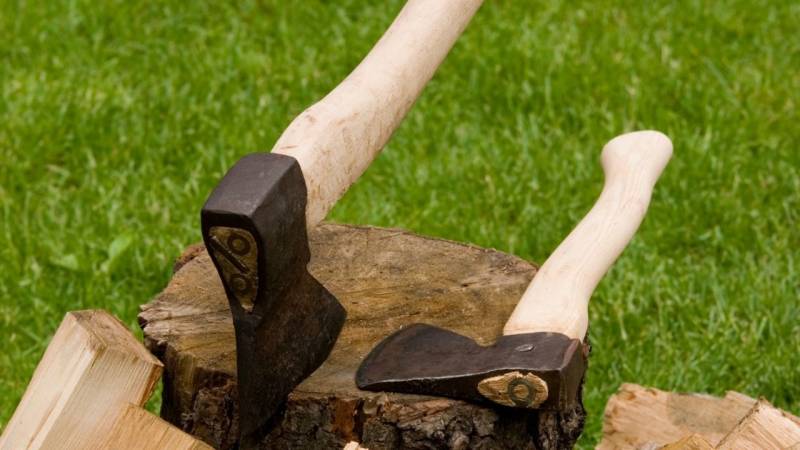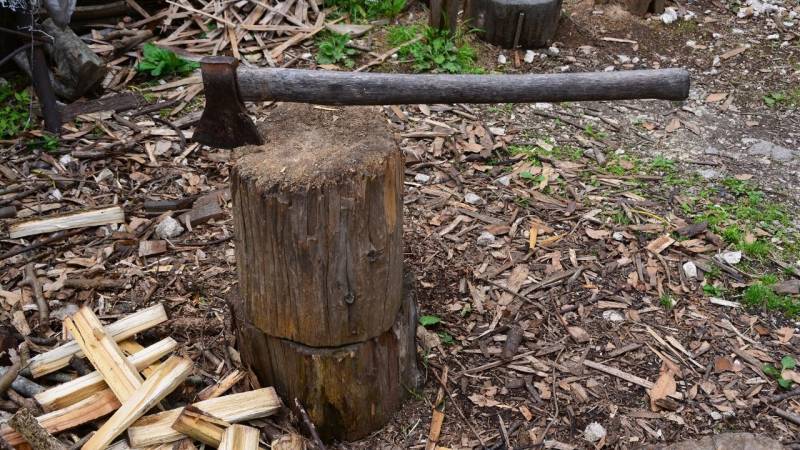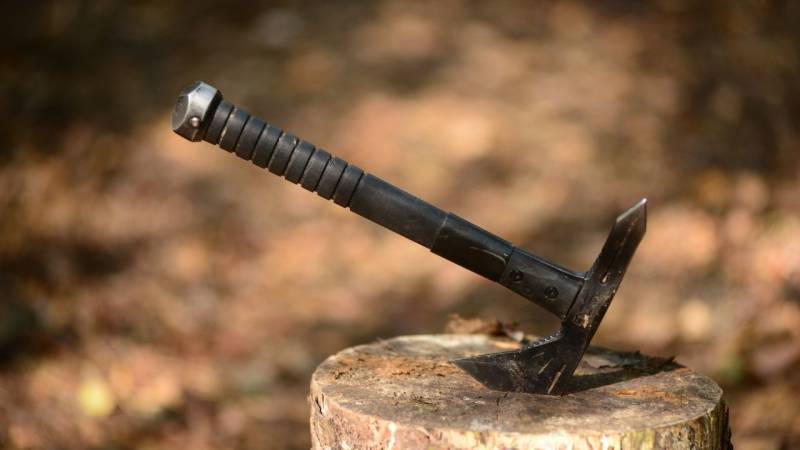
Hatchet or Axe - What is the Difference (+Recommendation)
👉 The key facts from this guide
- Axes and hatchets are both useful tools, but they have different functions. Axes are better for chopping large logs, while hatchets are better suited for lighter work.
- The portability and compactness of a hatchet improve it for backpacking trips, while the power of an axe makes it more effective for chopping wood.
- Hatchets are often equipped with multiple functions that expand their usability. For example, you could remove and drive in nails. None of these features are usually found on an axe.
- Axes are much heavier than hatchets. It is not always easy to carry an axe around, and it is almost impossible when you are backpacking.
- The article recommends the Schrade SCAXE5 survival hatchet and the Gränsfors Forest axe as good options for a hatchet and an axe, respectively.
- Before purchasing a hatchet or axe, you should make a list of your needs, so you know what to look for.
Hatchets and axes are both very useful tools for working in the forest.
It seems like they have the same functions, but that's not the case.
If you compare hatchets with axes, axes are much better suited for chopping large logs, while hatchets are better suited for lighter work. The portability and compactness of a hatchet improve it for backpacking trips, while the power of an axe makes it more efficient for chopping wood.
In this article, you will also learn the following:
- All differences between hatchets and axes
- When to choose an axe or a hatchet
- The best hatchet and the best axe on the market
What are the differences between a hatchet and an axe?
Axes and hatchets have blades that are hardly distinguishable, but they function completely differently.
What is a hatchet?
A hatchet is a handy tool with a sharp blade attached to a short handle, used primarily for chopping or splitting wood. It is smaller than an ax and suitable for precise tasks in bushcraft and camping.
What is an ax?
An ax is a tool with a heavy, sharp metal blade and a long handle, used for felling trees and splitting wood. It is larger than a hatchet and designed for powerful blows.

Let's now examine the advantages and disadvantages as well as the differences between the two tools.
Advantages of an Axe
- Axes allow you to generate incredible force with a single swing. You can quickly split a thick tree trunk or fell a tree with them. They are also much better for breaking through doors or other obstacles when you need to in an emergency. That would be quite difficult with a hatchet.
- The head of an axe is much heavier than that of a hatchet, which makes it even stronger. The heavier the axe head, the more force you can generate. Since axes have longer handles than hatchets, you can grip them with both hands. This means that you can better control the swinging motion, resulting in a precise swing.
- If you place your hands far back on the handle of the axe, you generate a faster swing, which in turn means more impact force. You should use longer handles if your arms are longer.
Disadvantages of an Axe
- Axes are much heavier than hatchets. It's not always easy to carry an axe around, and it's almost impossible if you're backpacking. You would use an axe more at home or when you're driving.
- Axes are usually pricier than hatchets, even though they have fewer features. This is because they require more metal and wood to manufacture. You won't find nail pullers or knobs on an axe, as they would hinder a more powerful swing. This can be a disadvantage or not.
Examples of how to use an axe
- Cutting down trees
- Splitting thick trunks

Advantages of an axe
- The compact size of a hatchet makes it ideal for backpacking, hiking, camping, and other long outdoor trips. You can't carry a heavy axe in your backpack, but hatchets have the perfect size for such adventures.
- Hatchets are often equipped with multiple functions that expand their range of uses. For example, you could remove and reinsert nails. None of these features are typically found on an axe.
- It is typically much more convenient to use just one hand, as with a hatchet. You can quickly remove branches from a tree and work more precisely with the hatchet. This requires hardly any energy, unlike the strenuous motion of repeatedly using an axe.
Disadvantages of an axe
- Since they are light and small, you won't be able to fell trees with an axe, and you also won't be able to split thick trunks with it. Axes are not designed for heavy-duty tasks, so you are limited in their use.
- Axes only provide enough space for one hand, so you have less control over them compared to an axe. You can't perform the same swinging motion as with an axe to optimize downward force.
Examples of how to use an axe
- Separate smaller branches from the trunk
- Create blanks, for example to carve spoons
- Sharpen wooden stakes, build a wooden hammer
- Create smaller pieces of wood
- Hack through bones

My recommended survival axe
If you're looking for a multipurpose axe, I currently recommend the well-made Schrade SCAXE5 survival axe. It is made from durable materials, constructed with high quality, and equipped with multiple functions. Once you have the axe in your hand, you won't want any other.
The carbon steel blade of the axe is suitable for cutting through sticks, branches, fish, animal skin, and more. You can easily open a tin can with the axe.
No matter if you're going camping or hunting, this axe will be useful. Weighing less than a kilogram, the axe is just right for day trips or even for your Bug-Out Bag.
The nylon sheath of the axe is quite sturdy and securely covers the sharp blade.
Among the other features of the axe are an ergonomic handle, a sharpened pommel, a nail puller, and holes for hanging with carabiners.
All in all, this axe is incredibly well-made, and the price is definitely worth it.
Here are the advantages:
- Includes sheath for storage
- Pre-sharpened carbon steel blade
- Comfortable, lightweight, ergonomic handle
- Special features included
My recommended axe
If you want to fell small trees, remove thick branches from the trunk, or make firewood, it's better to use an axe. My current favorite axe is the Gränsfors Forest Axe.
Since it is produced by a trusted hundred-year-old company that continues to produce consistent quality for its products, you won't find much better products.
The axe head made of carbon steel 56-57 HRC is hand-forged. On each axe head, you will find the initials of the blacksmith. A high-quality leather sheath is included with the purchase.
The handle is oiled and made of fine hickory wood. I especially like that the handle is smooth. This allows me to easily adjust my hand position while striking. At the end of the handle, there is also a hole for hanging the axe.
Although this axe has a good length, you can choose from a variety of other sizes from the manufacturer Gränsfors. For example, the manufacturer also offers a splitting maul axe, a long-handled felling axe, a forest hatchet, or a trail axe.
Every size has a specific purpose, so think about what you want to use your axe for beforehand - chopping wood or more for Bushcrafting?
Here are the advantages:
- Comes with a high-quality, smooth hickory handle
- Lightweight axe head
- Made by one of the most well-known brands
- Perfect size for chopping wood and collecting firewood
Final Thoughts
The fact is: Chisels and axes are both very useful tools. Size, performance, and weight are the three main differences.
Before you buy either one, you should make a list of your needs so that you know what to look for.
Maybe you will even find that you are better off with a knife or a machete.
Here is a brief summary of the guide:
- Hatchets are better for small branches or for delimbing, while axes are better suited for thick logs.
- Hatchets are lighter than axes and easier to transport.
- Axes are heavier than hatchets, but they provide more power.
- If you go camping, hiking, or backpacking, it's better to choose a hatchet.
- If you require more control when chopping, always decide an axe.
And in the end, I would like to recommend my guide "The most important axe skills you should master in the wilderness".


Author of the guide
Martin Gebhardt
Hey, I'm Martin. On my blog, you will learn the basics and numerous details about living in the wild. I think survival, bushcraft and the good life in nature are the keys to happiness. Find me here on Instagram or on YouTube. You can find more about my mission on the About Me page.
Since this is a gear guide, here ...
🤝8 reasons to trust my recommendation
-
Practical Experience: I have tested most of the products I recommend under extreme conditions myself.
-
Independence: As a wilderness mentor, I am not tied to any specific brands - this means my recommendations are unbiased.
-
Expertise: My many years of experience allow me to understand the intricacies and details of various products that a layperson might overlook.
-
Target group understanding: I understand the needs and challenges of outdoor enthusiasts, from beginners to seasoned experts.
-
Quality focus: I attach great importance to quality and longevity. These are characteristics that are crucial in the wild.
-
Clear communication: I try to explain the pros and cons of each product clearly and understandably so that you can make an informed decision.
-
Currentness: I always keep my guides up to date and adapt them to new findings or products.
-
Community Feedback: I work in wilderness schools, teach courses myself, attend courses and am active in various outdoor and survival communities and therefore integrate the feedback and experiences of others into my recommendations.
So when I introduce the best survival knives or flashlights, you can be sure that every recommendation is based on solid experience and extensive knowledge.
Was this guide helpful?
29 people found this guide helpful.
5.00 out of 5 points (29 Ratings)
Comments (0)
This post may contain affiliate links. So if you click on the links and make a purchase, I will receive a small commission at no additional cost to you. Click here, to learn more about it.



